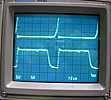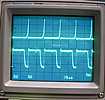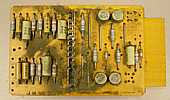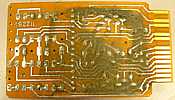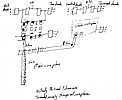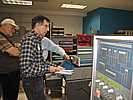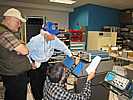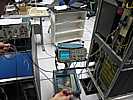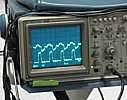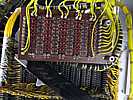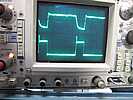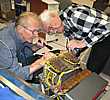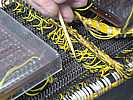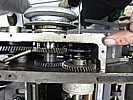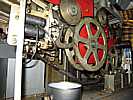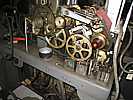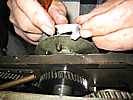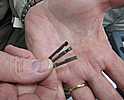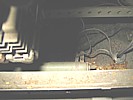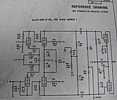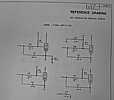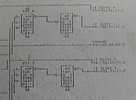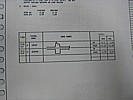Schedule April 2007
return to main 1401 Restoration Page
go to Team Bios
Contents:
Wed April 04 - general
Chuck's grand son, Ian came by today to hitch a ride from Mountain View to Morgan Hill. It's a good thing,
cause I lost the nuts and washers from the feed knifes from the 1402 and his sharp eyes found them, along
with a few extra washers we have dropped from time to time. I think he is about 14ish. Maybe we can get him on the team.
Regards,
- - - - - - Ron Williams provided the following - - - -
Bob Feretich and Ron Crane figured previous addressing problem - maybe they will have to work on this one.
Sat April 07 - die hards - or maybe "energizer bunnies"?
Still, Ron found the problem and got it working. Here are some pictures:
After card replacement
The signals should be mirror images of each other. The fact that the output signal (top trace) is so clean with a working board is Very Good. This signal is only used for the Z instruction. (The slow rise time seen on other signals in the machine that continues to cause intermittent Check Resets still needs to be debugged.)
If I'm remembering correctly from the machine schematics, the section that is bad is the circuit with T4, so Tim, if you have a chance, it would be interesting to find out if only T4 on that board is bad (and just how bad T4 is).
The bad board was placed in a plastic baggie, tagged with a yellow stickie, and placed into the "bad boards" box. Ron made plenty of notes to document this in the various logbooks, etc.
-Mike
p.s. to Tim: I got the initial loader program to work. Now I can get the full relocating loader going by using this absolute loader. It's pretty cool: no more piles of "setwm" instructions! It's 99 characters long.
Wed April 11 - general
OH - that reminds me - I asked Jim Somers if I could start a new rumor - That the 1401 crew was going to be treated
to a project third anniversary formal (black tie and tails) cocktail and dinner party, with brass band complete, at the Fairmont Hotel.
Have I confused you yet? If not, please explain the above to me ;-))
Fortunately, two years later, when I was studying a then state of the art machine, fast high current transistors were
readily available and "in" - switch cores were "out", and I didn't have to strain my brain :-)))
Sat April 14 - 2nd Sat - Volunteer Day
And here is the "contract" in HTML
and in WORD format
Wed April 18 - general
Wed April 25 - general
And the job ain't finished
Ed was giving some of Bob's grandchildren some standard demo paper out w/the visitor's name when the first two cards of the program loader were causing a check reset light to go on.
Further investigation showed that the initial 2 cards could be removed and the deck still loaded OK to print the demo.
----
Afterward, it was determined that a "cs 15999" instruction was failing; Ron and I tried to narrow in the range. The program was:
The failure is: the "B" with a wordmark at location 12 is _completely_ gone - all bits in that location are turned off, not even a check bit is on; this is, of course, invalid as well as strange, as the clear storage instruction is only supposed to clear (up to) 100 positions of core, NOT to be wiping out op codes and turning the next instruction into an invalid blank!
I made 16 cards that cleared storage on the addresses 15999, 14999, ...., 1999, 999 (these cards are now on top the 1402), and tried them one at a time. The rationale was that although it could be done via panel switches, that can be error-prone, and also because it was easy to try the 16 programs to see which ones worked, and this could be done systematically.
If the address was 7999 or below, the program worked normally.
If the address was 8999 or above, the program failed as described, above.
(I did not try to clear storage of 8000 [should clear one location] to see if it also causes the problem - I suspect so).
So it would seem that clearing storage on an address above 8000 causes the next instruction after the "cs" instruction to be replaced by all bits off.
This is a new problem, as far as I know.
p.s. John Toole brought Barry Boehm and entourage through the 1401 room this afternoon:
Sat April 28 - 4th Sat
Wed April 04 - general,
Sat April 06 - die hards
Wed April 11 - general,
Sat April 14 - 2nd Sat., - Volunteer Day
Wed April 18 - general,
Wed April 25 - general,
Sat April 28 - 4th Sat.
Since Bill Flora was out today I stole the feed knives from the punch side of the 1402 and put them on the
083 sorter. The dang thing kept on jamming with the same symptoms. Card turning sideways more than the
feed path will allow. (column 1 getting behind column 80). So, my theory is all wet or at least very
damp about the feed knifes. But, for the life of me I can't figure it out right now. But I will.
I better before Bill gets back and finds the knifes are missing on his punch unit.
I sent the 083 feed knives to Grant via Allen so he can sharpen them up.
They are worn badly which was verified by Bob Erickson.
Frank
Report by Mike Cheponis
I needed to help with the PDP-1 demonstrations on Saturday the 7th and I stopped by the 1401 room afterward, and lo and behold Ron Williams was there with scope a'blazing, debugging the "Z" instruction (MCS - Move Characters and Suppress Zeros, which is how his "powers of N" demo program prints the numbers). So I stayed a bit and generally lowered Ron's productivity.
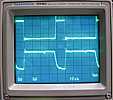
See Slow Circuit below.
Robert Garner was found this waiting for him.
We presume it was crafted by Ron Williams in memory of all the struggles we have had with this big 1401 project.
Greek Mythology, here it is, Sisyphus
struggled with the rock on the mountain -
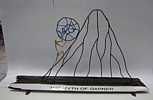
Jim replied that the plans were a bit more modest - a
combined something (with 1602, PDP-1, 1401, and ? groups) at the Computer History Museum, in ?late June?.
I think Jim said something about free apple juice. Oh well - reality strikes again ;-))
The meeting was most informative - Robert and I learned a lot more than did Jay McCauley :-)) Did you know that the museum
has at least four major "Special Interest Groups" run by volunteers (not including the various restorations)?
Robert Garner and Ed Thelen went off to meet with Jay McCauley about what the Information Technology group
could do for the 1401 group.

- IT Corporate History SIG
- Software Preservation SIG - Bernard Peuto
- Software History SIG
- Semiconductor Industry SIG - David Laws
and is there a Disc History SIG? - Jim Porter
all the above collect oral histories and documentation.
Hmmmm - what ever happened to the oral history, collected by "the museum" from Bob Erickson mid last year?? ?? Will we have to
collect one ourselves and transcribe it ourselves? It would be nice to have Bob Erickson still with us to
correct and enhance it. Bob is over 85 years old, what ever priority that indicates. Maybe "the museum" will give us
a copy to transcribe so some effort is not duplicated.
Frank King continued working on the input hopper/throat jam problem in the 083 sorter. The picker knives were evidently
not sufficiently bad to be causing all the problem - replacement picker knives (from the 1402 punch) did not fix the problem.
Frank King was greeted with this sign. Sublty is not our strong point, kidding certainly is,
and if you can't give/take a jazzing - life can be tough ;-))

Bob Erickson started working on remaining problems in
the upper 8,000 memory addresses. Here he is on the floor again - I though computers were supposed to be an
intellectual challenge. This time power is off - he is working on circuits that are not coil/transformer isolated.

The 1401 was designed before high speed (0.5 microsecond) high current (500 ma) transistors were commonly available.
As a result, there was a whole cult of using "switch cores" to drive the memory cores. Lower current transistors
could drive the 12 turns on the switch core to drive the 2 turns that drove the 1/2 select memory cores with 6 times
the current (and 1/6 the voltage).
And to save logic and switch cores, the switch cores also were driven as 1/2 current (requiring coincidence from two
drive sources to flip.
A refresher on core flipping
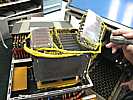
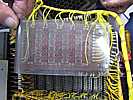
and the right hand plane of switch cores were coincident current selected by the hundreds digits and thousands decoding
of the address and drove the Y select wires in the main memory stack.
This is a grandson, Mason, who clearly is not yet a "touch typist". Remember when mostly girls took typing in high school?
I was intimidated, so bought a "how-to" book and learned on my own time :-))
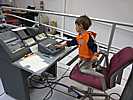
During the weekend, Mike Cheponis worked on the slow circuit problem above - below are the e-mails
Bob Erickson says that the spit out parts are nearly impossible to repair. The programmers think it is nice
to have sequence numbers in columns 72-80. Object decks use these columns also. As far as Bob is concerned, this unit is fine
for display - too much of a lifetime to get it going again.
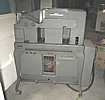
Front

Back

Gear Box

Spitting
Parts??
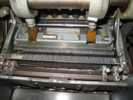
Missing parts
on left

Columns
71-80
missing :-((
Dan also remembered a very simple practical exercize that might help demo programming.

Gun Slinger?
Dan McInnis came by suggesting that we have a 1401 confidence test program. This would help assure the demonstrating
docent that the machine was functioning well enough to run demonstration programs. He also volunteered to write it.

To the left is the preliminary contract
The tale involves the sale by (the wrong tribe?) Indians (Native Americans) of Manhatten to the Dutch for a
reputed $24 worth of beads. Assuming the tribe invested $24 at say 4% for all these following years,
and didn't take any out for firewater, bingo, a nice cruise, Federal/State/Local taxes, lawyers ... How much
would the tribe have now? Almost anyone is sympathetic to the Indians, is interested in money, ...
Here is one analysis of the result
And
You may be surprised to learn that they [the speed up capacitors] are OK (!).
I tested them at 10 kHz on my cap meter, and at a higher freq.
Test setup for higher freq:
| | R=612 ohms
>-----| |----+-----/\/\/\/\/---------- gnd
| | |
Vi Vo
I set the sig gen to 10.0V p-p sin-wave, and then tweaked freq of sig gen until
Vo = 5.0 V p-p (meaning Xc = 612 ohms). [1]
Xc=1/jwC so C=1/jwXc
For one cap, C1 was 396 pf @ 657 kHz For other cap, C2 was 414 pf @ 628 kHz.
-----
We can substitute in these "bad" caps for the other two "good" caps
and my bet is that we won't see any difference to the "good" sections
- that is, these caps will work fine.
So I suspect the two transistors are hosed.
-Mike
[1] The reason for the 612 ohm value was that's what I got when 470 series
with 150 ohms came out to, and the back-of-the-envelope said 1 MHz should
have been the same Xc;
but the caps were larger than that so the point was lower in frequency.
Ed Thelen's remark - Interesting!! Tim's curve tracer caught some wierd effects at 60 Hz
in 2005 where transistors
So during a lull in tonight's 1620/PDP-1 meeting, Tim and I headed over to
the 1401 lab for some further checking. Tim brought some 330 pf ceramic caps,
and one was quickly soldered in and tested and... no difference!
No overshoot, like there should be.
After some further back and forth, we ended up re-installing the suspected
bad caps (so that now all the caps are original) and replaced T2 and T4
transistors with approved parts from the list for the 083 type transistor.
After those two transistors were replaced,
the card appeared to work normally on the bench test setup.
The card is in the plastic baggie, and is placed on "Ron's" document holder
(which normally sits between the 1401 and 1403). If he gets a moment,
maybe he can try this repaired card in the machine to make sure it works.
----
What's a little disturbing is that the curve tracer, operating at 60 Hz,
didn't catch this transistor failure.
My guess at this point is that the bad transistors' Cbe (base to emitter
capacitance) is abnormally high, therefore, any HF energy that one might
expect from a Miller speed-up cap gets dumped into that junction.
I have the bad transistors and I'll work them up into a simple wideband amplifier
circuit and see what the frequency response turns out to be.
-Mike
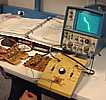 acted similar to reactive components. (We were conjecturing these were heating effects?) Now it appears we
must also test at rated speed to check for speed compliance. Interesting world!!
acted similar to reactive components. (We were conjecturing these were heating effects?) Now it appears we
must also test at rated speed to check for speed compliance. Interesting world!!
Please see Slow Circuit above, (appended after the Saturday report was posted)
Ron Williams explained some of the bugs that
bad word mark circuitry can produce. In this example, the circuit failed
during the summation of the 8 + 8 giving the 16. The zero suppress operation, reading from left to right hit a
word mark and quit suppressing zeros, giving the leading zeros on the 16. The next add operation, adding the 16 + 16
hit a word mark at the 6 and added 6 + 16, giving the 22. The intermittent word mark circuit started working again,
giving the rest of the page.

Bob Erickson had a change of mind about working on the sick IBM 513 Reproducing Punch above.
Dag Spicer gave us permission to further evaluate the machine.
Chris Garcia and ??? moved the machine into "our" 1401 Restoration Area.
That mass of relays left of the shoe connector near Bob's leg is an add-on to disconnect the 513 from a driving machine
when it is "off-line" doing reproducing rather than summary punching.

Ron Williams restored the switch on the maintenance console to its original function. see Hot Wire above.
He then carefully removed the masking tape label that had been applied so many years ago
to indicate the field wired change.
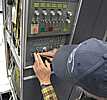
While some of the above was going on, Ed Thelen was upstairs "Xerox"-ing two manuals.
Bob Stetson came by and commented
that is father had worked for IBM, and that Bob had some momentos in his office.

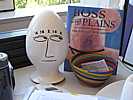
More problems remain in the upper 8,000 characters of memory.
Here, the top signal, from a sense amp, is "good", a "one"
and the lower signal, although looking rather good and of sufficient amplitude, is read as a "zero". We currently
do not understand what is going on. Appropriate boards have been swapped and replaced, (we think -
the schematics do not seem complete) and still the problem remains. (I didn't get a picture of the sample pulse.)
The test setup on the right gives the repeating sequence for scoping as seen on the left.
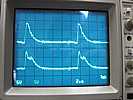

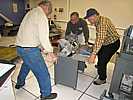
from left, Joe, Robert, Ron

Actually looks not bad :-))
Joe was vacuuming, and heard the rattle of something getting sucked in.
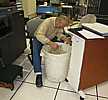
Well, lets see what it is :-|
some fun details -
The 513 card punch -

A friendly looking group

Examining Punch Dies

wiring - The motor generator works,
Ed Thelen gets no fun :-((
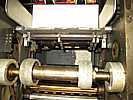
Special read brushes, four shown, when
connected with the

patch panel, can cause useful variations in punching
now for the gory details :-((

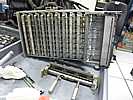


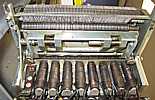
Ron and Bob worked some more on the 1406 extended memory
'till the paper work is done :-|

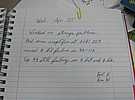
Gents,
Eric stopped up with me to the 1401 room this evening so I could try out some further quick test programs, in order to try to diagnose the latest problem that Ed discovered this afternoon.
1: sw 8,12
8: cs x999
12: b 1
the "x999" would be I9I (for 15999) R9I (for 14999) etc.
-Mike
http://en.wikipedia.org/wiki/Barry_Boehm
[Barry also got a personalized
Speaking of motors, look at the 513's starting capacitor that IBM moved. Why? To make room for the punch magnet assembly.
As Ron Williams said, "I bet there were some bad words said about that."
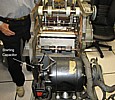
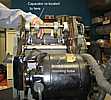
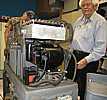
a) 3 of 4 transistors had a gain below 5, lowest he can measure - didn't fix what wasn't broke
b) pin "G" - the one reported bad - did not diode between the base and emitter :-(( - replaced
